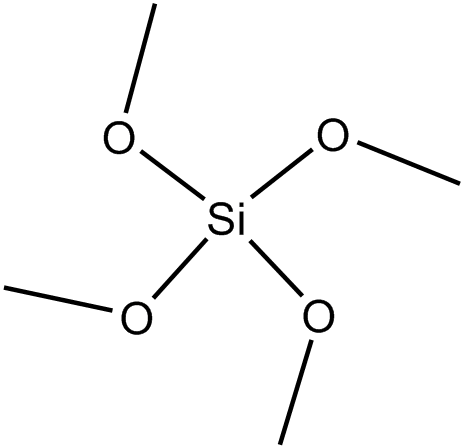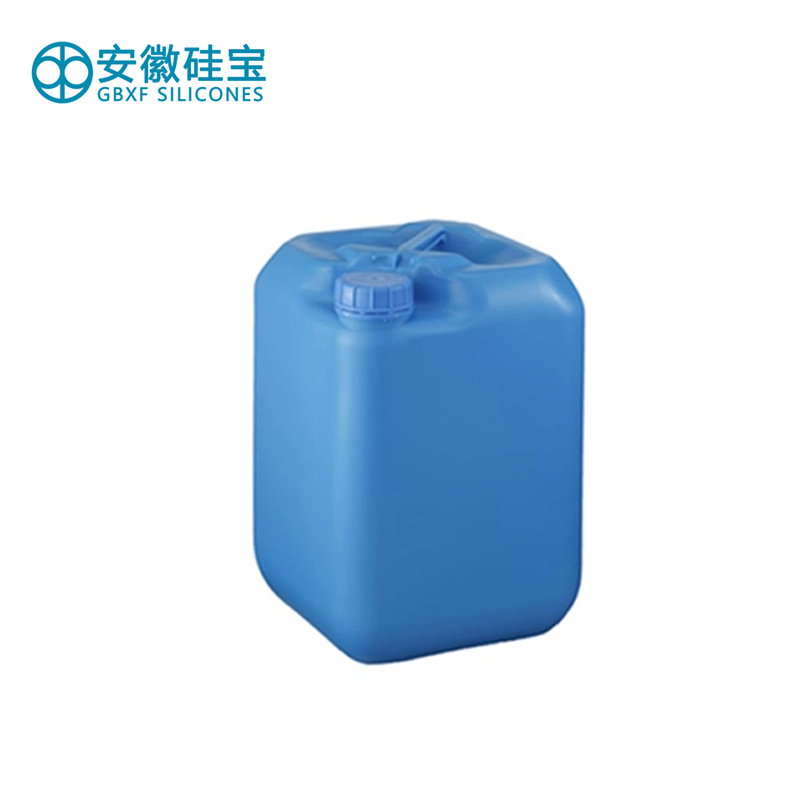
GX-162
SiLaneTMSilane coupling agent GX-162
Part I: Technical specifications of chemicals
1. Chemical name:
Tetramethoxysilane (methyl orthosilicate)
2. Molecular formula:

3. Molecular structure:

4 、 CAS NO.:
681-84-5
5. Corresponding brand:
KBM-04
6. Characteristics:
7. Application:
8. Typical Physical Properties
| Parameters |
Unit |
standard index |
| Appearance |
|
Colorless transparent liquid |
| Color |
Pt-Co |
≤25 |
| Density |
(P 20 g/cm3) |
1.015-1.035 |
| Refractive rate |
(nD 25°C) |
1.367-1.370 |
| Purity |
% |
≥ 97.0 |
9. Application Information
10. Safety Information
This document does not include safety information required for the safe use of this product. Before operation, please read the product and its safety data sheet and the container label to obtain information about the safe use of the product and the hazards to body, environment and health.
11. Validity Period and Storage
Sealed and stored in a cool, dry and ventilated place, moisture-proof and waterproof, away from kindling, heat source and light source. Under the above conditions, the storage period is six months.
12. Packaging
Finished products shall be packed in plastic drums, iron drums or iron-plastic drums, with net weight of 5Kg, 25Kg, 200Kg or 1000Kg per barrel. Special specifications shall be reserved.
13. Limited Warranty Information-PLEASE READ CAREFULLY
The information provided herein shall be deemed to be accurate on the basis of good faith. However, the conditions and methods of using our products are beyond our control. This information is not a substitute for customer testing to ensure that our products are safe, effective and fully satisfactory for a particular end use. This manual only describes the use of the product, and the actual application effect needs to be suitable for various application systems. The advice we provide shall not be considered as a cause of infringement of any patent rights.
Part II: Technical Specifications for Chemical Safety
Prepared in accordance with GB/T 16483 and GB/T 17519
1. Identification number of the substance
Product Details
Name of commodityTetramethoxysilane (methyl orthosilicate)
English Name: Tetramethoxysilane
Commodity Number:GX-162
Manufacturer: Anhui Sibao Organic Silicon New Material Co., Ltd
Enterprise Address: Wujiang Town Fine Chemical Base, He County, Ma'anshan City, Anhui Province
Sales Phone:025-58494046
Fax:025-58742173
Emergency telephone:0555-5963308(8:30-17;00)
Website:www.gbxfsilicones.com
Version:2.0
First Edition Time: April 7, 2017
Revision time: May 24, 2021
Information on emergency response: Department of Environment, Health and Safety.
Product recommend and Restricted Use:Industrial use only.
2. Hazard Overview
Emergency Overview
| Appearance and Character | Liquid |
| Color | Colorless transparent |
| Smell | No data |
Highly flammable liquids and vapors. Causing serious eye damage. Deadly if inhaled. May cause damage to organs (lungs). Long-term or repeated exposure may cause damage to organs (respiratory system, kidneys).

3. Ingredient/composition information
Substance/mixture: Substance
Chemical nameTetramethoxysilane (methyl orthosilicate)
Concentration Range: ≥ 97%(GC)
CAS No.:681-84-5
4. First-aid measures
Inhalation: If inhaled, transfer the person to fresh air and maintain a comfortable breathing position. Emergency medical treatment immediately.
Skin contactIF ON SKIN: Remove all contaminated clothing immediately. Wash skin/shower with water.
Eye contact: Rinse carefully with water for a few minutes. If contact lenses are worn and can be easily removed, remove the contact lenses. Continue flushing. If you still feel eye irritation: get medical advice/attention.
Ingestion: such as swallowing: do not vomit. Gargle thoroughly with water.
Most Important Symptoms and Health Effects: Not reported.
Advice for Protecting Rescuers: Refer to Part 8 for personal protection.
Special tips for doctors: symptomatic adjuvant therapy.
5. Fire protection measures
Fire extinguishing method and extinguishing agentAlcohol-resistant foam, carbon dioxide (CO2) or dry chemical powder.
Unsuitable extinguishing agent: Not reported.
particularly dangerous: Exposure to combustion products may be hazardous to health.
harmful combustion productsCarbon oxide, silicon oxide, silicon dioxide.
special fire extinguishing method:
Appropriate fire extinguishing measures shall be adopted according to the current situation and surrounding environment.
Spray water to cool unopened containers.
When safe, remove undamaged containers.
Evacuate the site.
Special Protective Equipment for Firefighters:
Wear self-contained breathing apparatus for fire fighting.
Use personal protective equipment.
6. Emergency measures for leakage
Personnel protective measures, protective equipment and emergency treatment procedures:
Environmental protection measures:
Avoid discharge into the surrounding environment.
If safety can be ensured, measures can be taken to prevent further leakage or spillage.
Methods of containment and removal of spilled chemicals and disposal materials used:
Absorbed with inert material.
In the case of large spills, containment or other appropriate leak-proof measures shall be taken to prevent material diffusion.
If the contained material can be pumped out, the recovered material shall be stored in a suitable container.
Remove residual spill material with a suitable absorbent.
Local or national regulations may apply to the release and disposal of such materials, as well as materials and articles used in cleaning up emissions. You need to determine the applicable regulations for yourself.
Parts 13 and 15 of this SDS give information about specific local or national requirements.
7. Operation, Disposal and Storage
Operation processing
Technical measures: See Engineering Controls in Section 8.
Local or general ventilation: Use only under adequate ventilation
Safety Handling Precautions:
Operate in accordance with good industrial hygiene and safety practices.
Storage
Arrange storage conditions:
Store in properly marked containers.
Store in accordance with specific national regulations.
Packaging Materials: Unsuitable materials: Not reported.
8. Exposure control and personal protection
Hazard composition and occupational exposure limits:
| Components |
CAS No. |
Value |
Control parameters |
Basis |
| Tetramethoxysilane (methyl orthosilicate) |
681-84-5 |
TWA |
1 ppm |
ACGIH threshold limit value (TLV) |
|
|
|
TWA |
5 ppm |
OSHA Threshold Limits (PLE) |
Occupational exposure limits for decomposition products:
Engineering Control:
Ensure adequate ventilation, especially in enclosed areas.
Reduce workplace exposure as much as possible.
Personal protective equipment:
Respiratory system protection: Use respiratory protection unless adequate local exhaust ventilation or exposure assessment demonstrates that the exposure level is within the recommended exposure guidelines.
Filter TypeOrganic gases and low-boiling vapor types
Eye surface protection: Use equipment tested and approved by official standards such as NIOSH (USA) or EN 166 (EU) to protect your eyes. Tightly fitted safety glasses.
Skin and body protection: Select appropriate protective clothing based on chemical resistance data and risk assessment of potential local exposure. Wear flame retardant anti-static protective clothing. Impervious protective clothing (gloves, aprons, boots, etc.) must be used to avoid skin contact.
Hand protectionRubber or plastic gloves.
Hygiene measures:
Make sure the eyewash and safety shower are located near the workplace.
When using, diet and smoking are strictly prohibited.
Contaminated clothes can be reused after washing.
The above precautions are only for room temperature operation, and additional precautions may be required for heat use or aerosol/spray application.
For further information on the use of silicones/organic oils in consumer product aerosols, please refer to the Silicone Industry Guidelines for the Use of Such Materials in Consumer Product Aerosol Applications (www.SEHSC.com).
9. Physical and chemical characteristics:
| Appearance and properties: liquid | Vapor pressure: no data available |
| Color: Colorless to light yellow | Vapor density: no data |
| Odor: No data | Density/relative density: 1.020 |
| Odor threshold: no data available | Solubility |
| PH value: no data | Water solubility: no data |
| Melting point/freezing point:-4 ℃ | n-Octanol/water partition coefficient: No data available |
| Initial boiling point and boiling range: 122 ℃-lit. | Self-ignition temperature: 360 ℃ |
| Flash point: 29 ℃ (closed cup) | Decomposition temperature: no data |
| Evaporation rate: no data | Kinematic viscosity: no data |
| Flammability (solid, gas): Not applicable | Explosive characteristics: non-explosive |
| Upper explosion limit: no data | Oxidizing: No data available |
| Lower explosive limit: no data |
Chemical nameTetramethoxysilane (methyl orthosilicate)
Molecular formula:C4H12O4Si
molecular weight:152.22
10, Stability and Reactivity
Reactivity: Not classified as a reactive hazard
Stability: No data.
Hazardous reactionNormal processing does not occur.
Conditions to be avoided: Heat, open fire and sparks.
Forbidden: Oxidizing agents.
Dangerous decomposition products
thermal decompositionOxides of carbon, oxides of nitrogen, SiO2
11, Toxicological Information
Pathway of exposureInhalation, skin contact, ingestion, eye contact
acute toxicity: No data.
Skin corrosion/irritation: No data.
Severe eye damage/eye irritation: No data.
Respiratory or skin allergies: No data.
germ cell mutagenicity: No data.
Carcinogenicity: No data.
reproductive toxicity: No data.
Specific Target Organ Systemic Toxicity-One ExposureSevere irritation to eyes, skin and respiratory tract. Vapor inhalation may cause pulmonary edema. Effects may be delayed and require medical observation.
Specific target organ systemic toxicity-repeated exposureThe substance may have effects on the kidneys and liver.
Inhalation hazardAt 20 ℃, the substance evaporates and can quickly reach harmful concentrations in the air.
12, Ecological Information
Eco-toxicity:
Persistence and degradability: No data
potential bioaccumulation: No data
mobility in soil: No data
Other harmful environmental effects: No data
13. Disposal
Disposal method
Residual waste: Handle according to local regulations.
Contaminated packaging: Empty containers should be sent to a permitted waste disposal site for recycling or disposal.
14. Transportation Information
International regulations
Land transportation (UNRTDG):
Air (IATA-DGR):
Sea (IMDG-Code):
15. Regulatory Information
Applicable regulations
List information of product ingredients in the following list:
the People's Republic of China occupational disease prevention law:
Classification Catalogue of Occupational Hazards (2015):Not included
dangerous chemicals safety management regulations:
Catalogue of Dangerous Goods Chemicals (2015):Not included
List of Explosive Hazardous Chemicals (2017):Not included
List of hazardous chemicals under key supervision:
List of the first batch and the second batch of hazardous chemicals under key supervision:Not included
Measures for the Registration of Environmental Management of Hazardous Chemicals (for Trial Implementation):
Catalogue of hazardous chemicals for key environmental management:Not included
Regulations on the Administration of Narcotic Drugs and Psychotropic Drugs:
varieties of narcotic drugs directory:Not included
varieties of psychotropic drugs directory:Not included
new chemical substances environmental management approach:List of Existing Chemical Substances in China (2013): Included.
16 Other Information
Further information
References: Internal technical data, data from raw materials SDS\OECD eChem portal search results, as well as the European Chemicals Agency, http://echa.europa.eu/
Version:2.0
First Edition Time: May 10, 2020
Revision time: May 24, 2021
Reason for revision: SDS standardized management
To the best of our knowledge and belief, the information provided in this SDS as of the date of publication is accurate. This information is intended only as a guide for safe operation, use, processing, storage, transportation, disposal and distribution and does not represent a warranty or quality statement of any kind. Except as specified in the text, the information provided in this table relates only to the specific materials identified at the top of this SDS, and the information in this table will not be valid when the materials in the SDS are mixed with any other materials or used in any process. The user of the material should review information and recommendations related to the operation, use, processing and storage methods required in the specific environment, including the suitability assessment of the user's final product SDS material (if used)
Previous
Next
Previous
GX-144
Next



